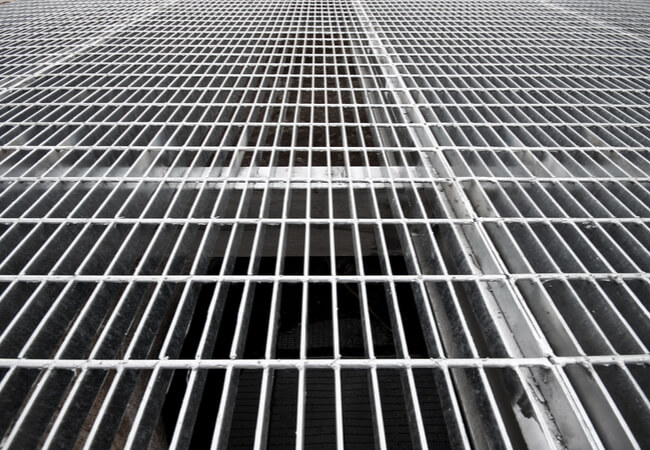Steel Bar Grating

Steel Bar Grating
Steel bar grating provides reliable traction and the ability for liquid, heat, air, sound, or light to pass between levels without the heavy weight of a solid steel plate of the same dimensions. Despite its light weight, bar grating is extremely strong and durable for load-bearing applications such as pedestrian and light vehicle traffic, and is fairly low-maintance, reducing operating costs. Because of these characteristics, it’s commonly used in fire escapes, gangways, operating floors, stair treads, drainage covers, and more. Steel bar grating is also available in a variety of bearing bar spacing and thicknesses depending on applications and load requirements.
Ready-to-ship bar grating near you
With locations throughout the Gulf Coast and Midwest, our warehouses can get you carbon steel grates quickly and competitively priced. We offer bar grating from ⅛” x 1¼” to ¼” x 1½” in both a bare and galvanized finish, serrated or smooth. Fill out the form above or call our team to get a free quote from a service representative.
Bar Grating Sizes
| Grate Width (in) | Grate Length (in) | Smooth/Serrated | Weight (lb/ft²) |
|---|---|---|---|
| 1/8 | 1 | Smooth | 5.10 |
| 3/16 | 1 | Smooth | 7.30 |
| 3/16 | 1 | Serrated | 7.30 |
| 3/16 | 1 1/4 | Smooth | 8.90 |
| 3/16 | 1 1/4 | Serrated | 8.90 |
| 3/16 | 1 1/2 | Smooth | 10.60 |
| 3/16 | 1 1/2 | Serrated | 10.60 |
| 3/16 | 2 | Smooth | 13.90 |
| 3/16 | 2 | Serrated | 13.90 |
STEEL BAR GRATING FAQS
Bar grating is generally broken into 3 primary types:
- Type W Grating (Welded) – Usually the most economical type, these grates are created by forge welding bearing bars and crossbars.
- Type SL Grating (Swage Locked) – This type of grating uses hollow tube crossbars that go through pre-punched holes in the bearing bars.
- Type DT Grating (Dovetail Pressure-Locked) – Using an “egg crate” configuration, these grates have crossbars that fit vertically into slots in the bearing bars.
Because of their clean, architectural appearance, press-locked steel grating is often used for more visible applications such as stairways, entranceways, and guardrails in addition to the standard uses of other grating types.
Bar grates are primarily made up of two sets of pieces: bearing bars and cross bars. Bearing bars are the longer, parallel bars that cross bars intersect and keep in place. Bearing bars often have pre-cut notches that each cross bar fits into, locking everything in place.
The span is a measurement of distance parallel to the bearing bars (and perpendicular to cross bars) between supports. For example, the “length” of a piece of grating between 2 beams is the span. The width of a piece of grating is the measurement of the crossbars.
Commonly seen in industrial stair treads and walkways, serrated bar grating has a notched surface (either along its bearing bars, cross bars, or both) to give additional traction in potentially slippery environments. Because grating is often used where liquid drainage is required, this need for extra grip is fairly standard for many locations.
Bar grating can have a wide range of prices based on size, rendered services, market conditions, and other factors.
For more detailed pricing please contact your sales representative. Request a quote.